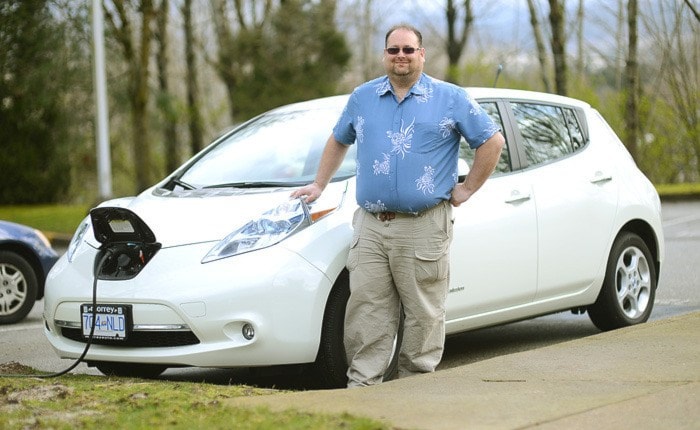Kelly Carmichael is used to the questions: How far does it go? How long does it take to charge? What happens when you run out of power?
The simple answers are: Well over 100 kilometres; it depends on what charger you use and how you drive; and you plan ahead so you don't.
Carmichael bought his Nissan Leaf, a five-passenger electric vehicle (EV), last October, becoming one of 100 buyers across Canada with 2011 models. Forty went to private citizens like himself, the rest to corporations, including BC Hydro.
Each day, Carmichael commutes about 30 kilometres each way from Newton to Burnaby, keeping the pearl-coloured hatchback tethered to a Level-2 (240-volt) charging station at the BCIT campus.
Carmichael, a research analyst at the Group for Advanced Information Technology – not coincidentally investigating the effect of EVs on electrical power grids – decided to test drive the car last May.
He expected it to be slow and handle like a "wet sponge."
Instead, it felt tight and sporty and he fell in love with it. He immediately put himself on an online waiting list.
When an email arrived saying a car was available for $38,000 – minus a $5,000 EV rebate – two things happened: One, Carmichael installed a seven-hour Level-2 charger at his house; and two, his kids suddenly inherited a Hyundai Santa Fé SUV.
The Leaf is powered by an 80-kilowatt electric motor that produces 100 horsepower and 210 lb.-feet of torque linked to the driveline by a single-speed, direct-drive transmission.
The juice is supplied by a 24 kW-h (kilowatt-hour) lithium ion battery (made of 192 individual cells) under the seats, which should have the car run anywhere from 100 to 160 kilometres under regular conditions.
To save power, there are accessories such as heated front and rear seats and a heated steering wheel to reduce the need to use the car's heating system.
He also programs the heat in the vehicle to turn on every weekday at 7 a.m.
"That's using the power from my house, not the power from my battery," he explains.
Carmichael uses an iPhone app called CARWINGS to remotely manage and control the vehicle's charging and check its status.
There's little maintenance to do: Tire rotations every 12,000 kilometres and a general check-up every year, along with a change of brake fluid. (The only other fluids are water used in the interior heating system and windshield washer fluid).
Carmichael says he's calculated the cost of eventually replacing the battery when it starts to wear down in several years. There are 50 kilograms of lithium in it that can then be recycled and sold, perhaps taking the sting off of the cost of a new battery, which could exceed $7,000.
Carmichael will be on hand on a couple of evenings and during the weekend at the Vancouver International Auto Show at B.C. Place Stadium April 3-8 to help with the Nissan Leaf display and answer questions.
For more information about the show, visit http://vancouverinternationalautoshow.com
For more information about Clean Energy Vehicles for B.C., visit http://www.cevforbc.ca/
